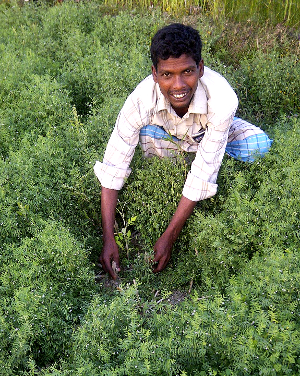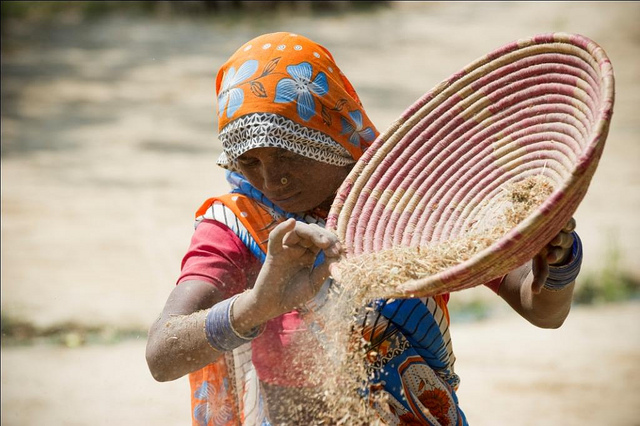“Little had been done to advance the genetic diversity of lentils.” This was the picture back in 2005, recalls Aladdin Hamwieh, a scientist at the International Center for Agricultural Research in the Dry Areas (ICARDA) based in Lebanon.
“Lentil has a narrow genetic base, meaning not too many varieties are used in production,” he explains.
It was on this premise that Aladdin joined a three-year global effort to capture and understand the genetic diversity of the world’s lentil varieties – a protein-rich crop that plays an integral part in the lives of many people in Central and West Asia and North Africa (CWANA), South Asia and North America.
He was funded by the CGIAR Generation Challenge Programme (GCP) to develop a refined set of genetic reference materials for lentils so that plant breeders across the globe could access the best gene pool available to be able to improve food security in developing countries.
“Essentially, the genetic make-up of lentil was repeatedly filtered until 15 percent of ICARDA’s gene bank was collected,” says Aladdin.
ICARDA has the largest collection of lentil genes in the world. Some work had been done on improving the genetics of lentils to withstand harsh, dry conditions. But it was not enough to prepare for the challenge the world is now facing – feeding almost 10 billion people by 2050 and climate conditions that mean longer dry periods and more erratic rainfall.
The reference set captures the existing genetic diversity of lentils and makes it easier for scientists to search for genes that can help overcome the challenges to lentil production. It consists of about 150 accessions, or 15 per cent of the global collection studied (see box).
Creating the reference set immediately helped researchers to understand more about lentils. “The major outcome was that different gene pools were identified where accessions from Europe and America were clearly separated from Asia and Africa,” Aladdin says. “Accessions from India, Afghanistan and Pakistan were also separated from accessions from the Middle East and North Africa.”
A common resource for lentil breeders
International cooperation and knowledge sharing are hallmarks of GCP, with one of the Programme’s key goals being to facilitate collaboration between scientists from across the globe in breeding new varieties of crops that can not only tolerate drought, but also resist diseases and tolerate poor soils. Ashutosh Sarker, a former lentil breeder and currently Coordinator and Food Legume Breeder for ICARDA’s South Asia and China Regional Program, says production challenges for lentils vary from country to country. While demand is rising globally, he says, some developing countries are having trouble meeting their own need for this staple food.
This was where the GCP work came in; its purpose, according to Aladdin, was to “develop a diverse reference set that is small and easy to handle. This way, it can be sent around the world for scientists to simultaneously screen for desirable or undesirable traits. This has important implications for developing countries.”
The reference collection serves as a common resource for all lentil breeders interested in the same crop.
“These materials can be accessed to achieve farming goals – to produce tough plants suitable for local environments. In doing this, farmers have a greater likelihood of success, which ultimately improves the wider population’s food security.”
When Aladdin’s team studied the reference collection, they were able to identify favourable genes.
“This enables us to look at the genes of plants and highlight those traits that best suit certain environments,” he says, “and then breed plants to be better adapted.”
Diversity is key to searching for valuable breeding traits
Shiv Kumar Agrawal, who joined ICARDA in 2009, uses the reference set developed for GCP to identify and create markers for drought-tolerant and early-maturing traits for key lentil-producing countries, including Bangladesh, Ethiopia and India.
“Developing more markers will help mitigate lentil’s barriers to production,” says Shiv, pointing to climate change and rising temperatures in production zones as adversely affecting lentil yields.
Markers are like genetic ‘tags’ that indicate which plants or seeds have particular genes, so markers related to relevant genes – for traits such as heat tolerance, for example – can help breeders choose which plant materials to use when developing a new variety.
“Breeding for this should be a priority,” he continues. “Developing heat-tolerant lentil plants would help to expand the area of legume cultivation, stabilise yield in areas prone to heat stress and mitigate impacts of global climate change in the future.”
This is the same for other traits, he says, which would improve food security in developing countries: “Developing extra-early breeds of lentils has great scope in diversifying cropping methods and gives more flexibility for farmers.”
Karthika Rajendran, a postdoctoral student working with Shiv at ICARDA, uses both conventional and molecular-breeding approaches to develop heat-tolerant lentil cultivars that mature early. The products of GCP, she says, are “helpful to identify the source of genetic diversity and molecular markers for the traits identified under each research targets.”
Like Shiv, Karthika stresses the value of heat-tolerant varieties for heat-stressed areas and in reducing the impacts of climate change, and adds that improving other traits alongside also has significant impacts: “The development of machine-harvestable lentils reduces the production cost, increases the farm profit, reduces the drudgery of women and improves the nutritional and food security of smallholder farmers in developing countries.”
While achieving such lentil varieties may be some way down the track, Shiv and Karthika offer a small glimpse of what the future holds and the promise of making even more from GCP’s genetic reference set than what has been achieved so far.
Preserving genetic resources
Aladdin Hamwieh is also looking to the future: “We don’t know what tomorrow brings, so people need to understand the value of such genetic reference material.”
He reflects on the reality of how civil unrest in developing countries often means local agriculture is disrupted and crops destroyed, which can mean the loss of traditional varieties.
“We could lose interesting genes from these,” says Aladdin. “We must therefore maintain and protect the ICARDA database, because it stores important information that the next generation won’t be able to study in nature.”
Aladdin is adamant that this is important not only for developing countries but for the whole world. “We can’t make genes in future so this one we cannot lose,” he stresses.
A ‘backup’ duplicate copy of ICARDA’s lentil collection is stored in the Arctic Circle at the Svalbard Global Seed Vault.
Groundwork on lentils ‘gave orientation to future breeding efforts’
Although GCP’s genetic research work on lentils came to an end in 2007, scientists all over the world can still access the materials – and are reaping other benefits from GCP’s work too. For example, ICARDA is using GCP’s Integrated Breeding Platform (IBP) – particularly the Breeding Management System (BMS) – for its lentil-breeding programme.
Reflecting GCP’s collaborative spirit, Shiv explains that his team have not only successfully integrated use of BMS within their own programme, but have also included it in regular training programmes for developing country partners.
Karthika says, “We use the BMS to store historical data of crossing blocks and germplasm collections and to create fieldbooks, field maps and labels of yield trials. We use the crossing manager to build up the list of the crossing blocks, and the breeding manager to maintain the pedigree of the breeding programme.”
She explains that within the BMS, “the breeding view demonstrated a great potential to analyse the phenotypic and genotypic data for single and multienvironmental conditions,” and notes that “the Molecular Breeding Design Tool would be useful in the process of marker-assisted selection.”
ICARDA plans to implement the BMS to develop fieldbooks for Lentil International Elite Nurseries, using the IBFieldbook tool, and to distribute the books to developing country partners for data collection.
“Once the database is centralised, it will facilitate rapid access to breeding material and easy sharing of knowledge and technology to the developing country partners,” says Karthika.
Such ongoing advances in breeding technologies since the outset of GCP mean the refining process can continue.
“We should not stop,” says Aladdin, encouraging other lentil breeders and researchers to continue their work.














